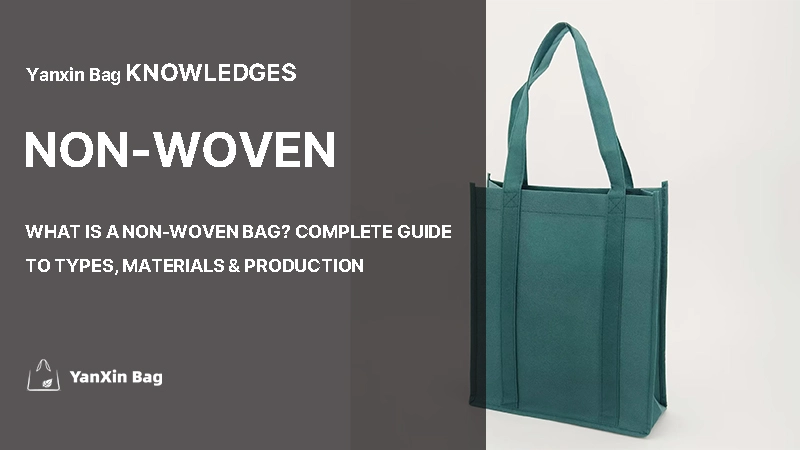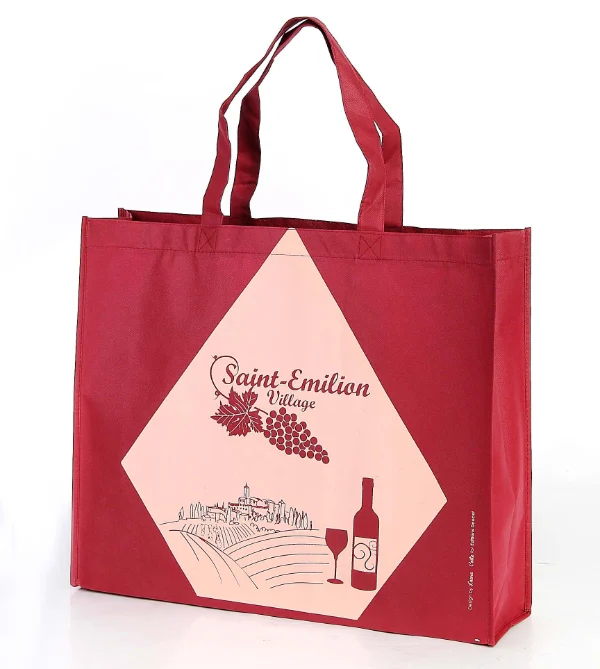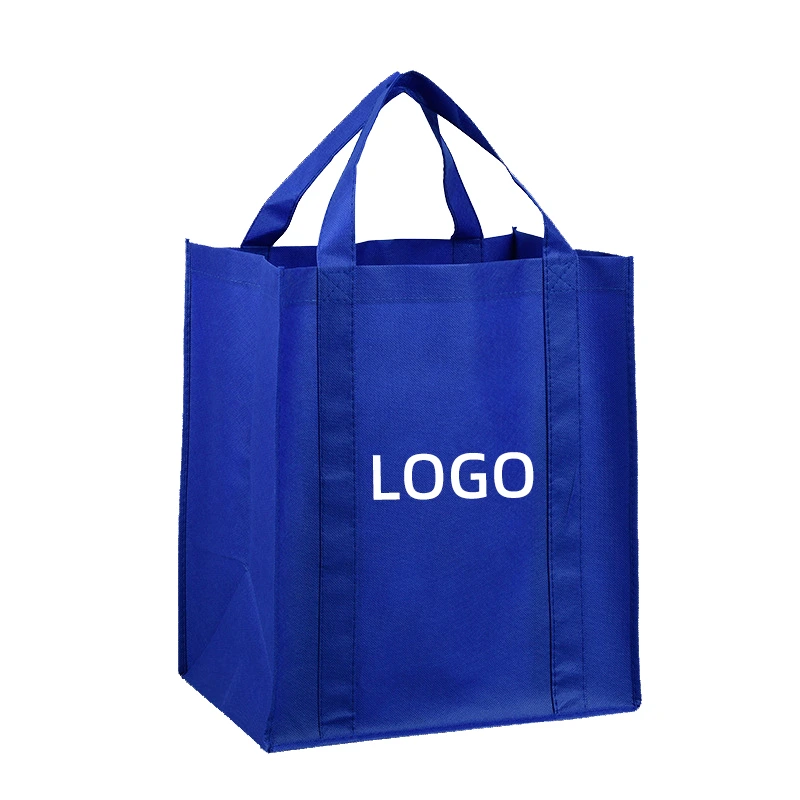Our Academy

With the growing global emphasis on environmental protection and plastic reduction, non-woven bags have gradually become an ideal choice for packaging, shopping, promotions, and other scenarios due to their reusability, lightweight durability, and good printing performance. Especially in corporate customization and brand promotion, non-woven bags have become one of the most popular eco-friendly bags due to their low cost and high visibility.
A non-woven bag is an eco-friendly bag made from non-woven fabric. This fabric is formed by melting and spinning polypropylene (PP) pellets into fibers, which are then bonded together through heat-sealing or adhesion. Non-woven bags are lightweight, durable, reusable, and easy to print on, making them widely used in shopping, packaging, promotions, exhibitions, and many other scenarios.
Although we already understand the basic definition of non-woven bags, a deeper understanding of their manufacturing methods, material structure, and the characteristics of different bag types will help you make more suitable choices when customizing purchases or promoting your brand. Continue reading to systematically learn more detailed information about non-woven bags.
A non-woven bag is an eco-friendly, reusable shopping bag made from non-woven fabric. Unlike traditional woven or knitted materials, non-woven fabric does not require interlacing yarns. Instead, it is made by melting polypropylene (PP) plastic pellets at high temperatures, drawing them into fibers, and then bonding these fibers into sheets using heat, mechanical, or chemical methods to form a flexible and lightweight fabric. Due to its low production cost, stable material, and good printing performance, it is widely used for supermarket shopping, product packaging, exhibition promotions, promotional gifts, and other purposes.
Lightweight and Portable Non-woven bags are light overall, making them easy to carry and store daily. Their foldable structure allows them to be easily stored in drawers, luggage, or car trunks when not in use, taking up minimal space and convenient for having on hand.
Durable and Tear-Resistant Made from polypropylene material, they possess good tensile strength and tear resistance. Even with frequent use, the bag body is not prone to damage and can be reused for a long time, reducing the frequency of replacement.
Good Breathability The fiber arrangement structure of non-woven fabric has natural breathable pores, which can effectively prevent stuffiness and odor accumulation. This is especially suitable for storing fresh food, clothing, shoes, and other items that require ventilation.
Some Water Repellency Although not completely waterproof, the surface of non-woven fabric has a certain degree of water repellency. It can provide basic protection against light rain or minor water splashes, effectively protecting the contents of the bag from moisture.
Print-Friendly The surface is smooth and flat, suitable for various printing processes such as screen printing, heat transfer printing, and lamination printing. The printing effect is clear and vibrant, which is beneficial for corporate brand display and promotional activities.
Low Cost Compared to natural fiber materials like canvas and cotton, the production process for non-woven bags is more efficient, and raw materials are readily available. The overall production cost is lower, making them suitable for large-scale custom production, especially for corporate promotions and gift-giving purposes.

The W-cut non-woven bag has a W-shaped handle opening cut at the top. The larger handle area offers a comfortable grip. The bag typically has a flat structure with no bottom and uses ultrasonic heat-sealing for the edges, ensuring high production efficiency and good cost control. Compared to D-cut bags, it has a wider opening and slightly larger capacity, making it better for carrying bulkier lightweight items. It’s widely used for supermarket shopping, promotional giveaways, and at large events, particularly for mass production and distribution.
The non-woven bag with a bottom features a bottom panel design added to the bag’s base, creating a simple three-dimensional structure that increases capacity and stability. Compared to flat bags, it can better support wider or thicker items like promotional materials, small product packaging, and sample bags. This type of bag still uses ultrasonic heat-sealing and has a moderate cost. It is suitable for lightweight uses such as retail packaging, mall giveaways, and trade show material bags, offering a good balance between convenience and carrying space.



This non-woven bag features a box-shaped structure with gussets on both the bottom and sides that expand. It offers ample capacity, and its shape is stable and attractive. It’s suitable for packaging large or multiple items and is widely used for supermarket shopping, food delivery, apparel packaging, and brand giveaways. This bag uses ultrasonic heat-sealing, resulting in neat edges and a strong seal. It excels at balancing appearance, load-bearing capacity, and cost control, making it especially suitable for supermarkets, wholesale markets, and brand promotions.


The non-woven bag with reinforced handle enhances overall load-bearing capacity and durability by extending and stitching the handles down the sides of the bag. It’s often used for applications needing higher carrying capacity, like grocery bags[3] and supermarket shopping bags. The sides are typically designed wider to increase the bag’s overall capacity, making it convenient for carrying large or heavy items.
The drawstring non-woven bag features a drawstring closure at the top for quick opening/closing and securing items. Some styles can be paired with shoulder straps to function as lightweight backpacks, while others are simple pouch-style bags suitable for storing and carrying various lightweight items. This bag type is widely used for sports equipment, student bags, promotional giveaways, event souvenirs, and for daily portable organization and storage.


The foldable non-woven bag is designed to be lightweight and flexible. It can be folded into a compact size, making it convenient to carry as a spare. Some styles include a built-in pouch or snap button for quick and easy folding and storage, making them ideal for on-the-go use.
Printed non-woven bags involve custom printing of brand logos, designs, slogans, or colorful images on various types of non-woven bags. Almost all bag types, such as D-cut bags, tote bags, laminated bags, and drawstring bags, can have printing applied to meet different brand promotion and retail needs. Common printing methods include screen printing, heat transfer, and flexo printing. The most suitable process can be chosen based on the complexity of the design and material characteristics.

Besides being categorized by bag design, non-woven bags can also be divided into two main types based on their production process:
Heat-sealed non-woven bags use ultrasonic technology to directly fuse non-woven materials together, eliminating the need for stitching. This process is efficient, suitable for mass production, and results in bags with neat and attractive edges. Common heat-sealed bag types include D-cut bags, W-cut bags, bags with a bottom, and three-dimensional bags with both bottom and side gussets. These bags are low-cost and have a simple appearance, making them widely used for promotions, supermarkets, and exhibitions. However, compared to stitched bags, their load-bearing capacity is weaker, so they are better for carrying light to medium-weight items.
Stitched non-woven bags are assembled using industrial sewing machines with thread. The stitching is strong, creating a sturdy and durable structure that can bear heavier weights and is suitable for long-term repeated use. Typical stitched styles include tote bags, bags with reinforced handles, and foldable bags. Although the stitching process is more complex, slightly more expensive, and has a somewhat longer production cycle, the finished products are stronger and have a more premium feel. This makes them suitable for high-quality brand customization and business gifts.
In summary, non-woven bags, as an important choice for eco-friendly packaging today, are widely used in shopping, promotions, packaging, and various aspects of daily life due to their lightweight durability, moderate cost, reusability, and good customizability. Understanding the basic definition, production processes, core features, and application scenarios of non-woven bags helps businesses make more suitable decisions for their needs when customizing purchases. Whether for brand promotion, commercial activities, or sustainable development goals, choosing the right non-woven bag solution is a wise choice that balances practicality and environmental considerations.
If you are looking for a professional non-woven bag custom manufacturer, Yanxin Bag offers a variety of sizes, styles, and printing process options that can be flexibly customized according to your brand needs. We support low minimum order quantities, stable quality, and efficient delivery to help you achieve your brand packaging and promotion goals. If you need to learn more about custom solutions and reference samples, feel free to contact us anytime.
1Discover top strategies for corporate promotions that can elevate your brand and attract more customers.
2Learn about the key factors that enhance bag durability and load-bearing capacity, ensuring you choose the right bag for your needs.
3Discover sustainable options for grocery bags that are both eco-friendly and practical, enhancing your shopping experience.
4Learn about BOPP film’s properties and its significance in enhancing packaging quality and durability.
Answer: They are lightweight and durable, reusable, can be custom printed, and are low-cost, making them suitable for various commercial uses and eco-friendly promotions.
Answer: You can customize the size, color, printed designs, handle styles, closure design, and whether to add lamination, to meet the needs of different scenarios.
Answer: Shopping bags, gift bags, promotional bags, brand advertising bags, product packaging bags, conference material bags, food delivery bags, and more.
Answer: A non-woven bag is an eco-friendly bag made from synthetic fibers like polypropylene (PP) using thermal bonding, mechanical entanglement, or chemical bonding techniques. It does not require weaving or knitting like traditional textiles; instead, fibers are directly bonded into a fabric, widely used in shopping, packaging, and promotional fields.
Answer: Non-woven bags do not require a weaving process and feel like fabric but have a simpler manufacturing process. Woven bags are made by interlacing yarns, offering higher strength but at a relatively higher cost. Paper bags are easily degradable but have poor water resistance and durability. Non-woven bags combine the advantages of being lightweight, low-cost, and reusable.
Answer: Pros include: lightweight, durable, water-repellent, good breathability, easy to print, customizable, and low cost. Cons are: not easily biodegradable, more complex recycling process, and long-term use may produce microplastic fragments.
Answer: Non-woven bags have some water-repellent properties and can resist light rain and water droplets, but they are not completely waterproof. If high water resistance is required, choose laminated non-woven bags.
Answer: When reused reasonably and properly recycled, non-woven bags are much more eco-friendly than single-use plastic bags and can significantly reduce plastic waste. However, from the perspective of the raw material itself, it is still a plastic product.
Answer: Yes. The surface of non-woven fabric is flat and suitable for various printing methods such as screen printing, heat transfer printing, and lamination printing. This makes it convenient for businesses to print logos, brand information, or advertising designs, widely used for promotions and brand advertising.
Answer: Yes. Non-woven bags are primarily made of polypropylene (PP), which is a recyclable plastic. However, the actual recycling effectiveness depends on local recycling facilities and sorting systems.
Order or no-order we are Always here to help you!
We will contact you within 1 working day, please pay attention to the email with the suffix “@yanxinbag.com”.
Order or no-order we are Always here to help you!
We will contact you within 1 working day, please pay attention to the email with the suffix “@yanxinbag.com”.